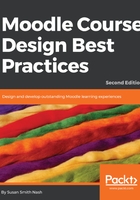
Planning Your Course
In the previous chapter, we reviewed the basics of Moodle and learned how to get started with site-wide settings and configurations. Now we will take a step back and review the basics of pedagogy and instructional design. They are important as you set up your educational programs and build courses in Moodle. If you fail to take pedagogy and instructional design into consideration early in the process, you run the risk of having to rebuild your courses later, which can be very tedious, time consuming, and expensive (in terms of labor). So, it's a great idea to bookmark this chapter and return to it often, each time you begin to develop a new program, course template, demo course, or individual courses.
Let's start with a fundamental question: what would you like your students to be able to do after they complete your course?
It sounds like a simple question, but it's the key to setting up an effective structure for your Moodle course and also to selecting the best possible resources, activities, and assessments. You will map all of your resources, activities, and assessments to the learning objectives, so the learning objectives (the concrete statements of what your students should be able to do to demonstrate their knowledge or skills) are what you should keep in mind at every possible moment.
So, it is doubly important to keep in mind, as you plan your course, it is important to keep in mind what you want your students to learn and, then, how you would like them to demonstrate their skills and knowledge. In doing so, you can plan your course so that it has a clear, logical structure, and that the elements tie neatly together and reinforce one another.
We'll learn how to use course-level learning outcomes as the foundation for your course. Using course-level learning outcomes, we're starting with the "big-picture" view. Then, we'll take a closer look at each of the sections in your course and learn how to create more specific learning outcomes that will serve as the framework that ties the big-picture goals to the resources, activities, and assessments of your course. With such a solid foundation and framework, you'll never feel lost or frustrated as you build your course. Instead, you'll feel confident as you select your course's resources, activities, and assessments.
In this chapter, we'll discuss the following topics:
- Writing and using learning outcomes spanning the course
- The importance of outlining learning outcomes
- The ideal course structure
- Universal Design for Learning (UDL)
- Selecting resources and activities
- Effective assessment strategies